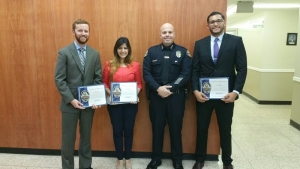Social Work Students Partner with Police to Take Down Crime
March 31, 2015 / by Shirley S. Shin- Alumni
Stealing snacks from the corner store. Spray-painting tags on public property. Vandalizing cars.
What’s a parent to do?
USC School of Social Work students just may have the answer. Using evidence-based frameworks, Master of Social Work students have teamed up with the Gardena Police Department to develop the Gardena Juvenile Justice and Intervention Program, an early-intervention program focused on reducing the recidivism rate of youth cited for minor crimes and intervening with kids who are at risk for police interactions.
By pairing police with social workers, the program aims to reduce the likelihood that these youth will continue down a path of repeated involvement with the criminal justice system.
“Other cities have diversion programs … from a criminal justice perspective on behavior,” said Andrew Haacke, who is in a dual degree program working toward an MSW and a Master of Public Administration. “We’re trying to see this from a social work perspective rather than a punish-first-and-rehabilitate-later approach.”
The intervention program, which will serve approximately 50 to 75 kids a year, was the brainchild of Police Chief Edward Medrano, EML ’10. He wanted to build a program on a local level that would help keep kids out of the criminal justice system.
“The police chief had the vision. He didn’t know how to [develop the program] but knew social workers and students from USC could do it,” said Carlos Madrid, who is also in the MSW/MPA program, and along with Haacke and now-alumna Erika Duarte, helped to shape the intervention. “Using evidence-based practices, doing research, seeing what else is out there – what’s worked and what hasn’t worked – we incorporated it into a program that caters to the needs of the city.”
How it works
Built with a social work mindset, the program looks at the whole picture of youth as a means of understanding why they are involved in certain situations. The services span four areas: ongoing and frequent case management; life-skills training workshops; referrals to community agencies for intensive services, such as substance abuse, depression and suicide ideation; and assignments of minor sanctions that fall in line with the concept of restorative justice, such as a small fine, workshop attendance or a letter of apology.
A full-time casework supervisor and four caseworkers, made up of first-year MSW students from USC or California State University, Dominguez Hills, will oversee the day-to-day intakes.
“The theory behind juvenile justice … is based on risk assessment. The higher-risk youth will need more support, more interaction [with our caseworkers],” Haacke said. “The caseworkers will talk to the youth, contact parents, contact their schools to figure out what’s going on in their lives. We want to find out everything that’s contributing to get them in the situation in the first place.”
There are two ways in which kids enter the program. After a youth gets cited for a misdemeanor or below, juvenile detectives will decide whether he is a suitable candidate for the program. The youth will then have the opportunity to choose to go through the intervention or the county court system. If the youth opts for the program, he will be required to meet regularly with a caseworker before the citation is eliminated from his record.
“As soon as the tickets come in, within 24 hours they should be on the juvenile detectives’ desk,” Madrid said. “With our program … our hope is to reach them in three to seven days. Having [an immediate] connection with the police department ensures that the repercussions to their actions are met quickly, and they get the services to assist them with their deeper problems.”
The second way is voluntary participation. Youth or parents with at-risk youth interested in the program have the opportunity to meet with a caseworker to receive recommendations for services.
Early progress
“It is extremely impressive to witness what Andrew and Carlos have achieved in a relatively short period of time,” said Sandra Williams, Haacke and Madrid’s field liaison. “I believe that their work has had and will continue to have a transformative effect on not only the Gardena Police Department and the youth they serve but the surrounding communities as well. The youth program … could very well serve as a model to be replicated at other police departments.”
Throughout the planning process, the team has successfully built relationships with the local high school, community partners and local service providers who will be key to the success of the program. The intervention team is also working closely with the police officers and juvenile detectives so that everyone involved understands the importance of the program, how it works and how it affects their daily duties.
“The goal … is to educate, support and improve the lives of at-risk youths to become productive and contributing members of society,” Chief Medrano said. “We hope that our services can show our investment into our youth and to truly make a difference in their lives and the lives of those in our community.”
Since its start in February, the intervention team has received more than 50 referrals. The program’s grand opening celebration is scheduled for this spring.
To reference the work of our faculty online, we ask that you directly quote their work where possible and attribute it to "FACULTY NAME, a professor in the USC Suzanne Dworak-Peck School of Social Work” (LINK: https://dworakpeck.usc.edu)
